Photonic Hooks Generated by a Concave Micro-Cylinder Based on Structure-Constrained Functions
Abstract
1. Introduction
2. Models and Method
3. Results and Discussion
3.1. Changing of y Coordinate of the Upper Intersection M
3.2. Changing of y Coordinate of the Lower Intersection N
3.3. Changing of x Coordinate of the Vertex P
3.4. Realizing the Adjustable PHs by Controlling Function Coefficients
4. Conclusions
Author Contributions
Funding
Data Availability Statement
Conflicts of Interest
Appendix A
Appendix B
References
- Adler, C.L.; Lock, J.A.; Stone, B.R.; Garcia, C.J. High-order interior caustics produced in scattering of a diagonally incident plane wave by a circular cylinder. J. Opt. Soc. Am. A 1997, 14, 1305–1315. [Google Scholar] [CrossRef]
- Adler, C.L.; Lock, J.A.; Hovenac, E.A. Exterior caustics produced in scattering of a diagonally incident plane wave by a circular cylinder: Semiclassial scattering theory analysis. J. Opt. Soc. Am. A 2000, 17, 1846–1856. [Google Scholar]
- Chen, Z.; Taflove, A.; Backman, V. Photonic nanojet enhancement of backscattering of light by nanoparticles: A potential novel visible-light ultramicroscopy technique. Opt. Express 2004, 12, 1214–1220. [Google Scholar] [CrossRef]
- Li, X.; Chen, Z.; Taflove, A.; Backman, V. Optical analysis of nanoparticles via enhanced backscattering facilitated by 3-D photonic nanojets. Opt. Express 2005, 13, 526–533. [Google Scholar] [CrossRef]
- Weekes, S.M.; Ogrin, F.Y.; Murray, W.A. Fabrication of Large-Area Ferromagnetic Arrays Using Etched Nanosphere Lithography. Am. Chem. Soc. 2004, 20, 11208–11212. [Google Scholar] [CrossRef] [PubMed]
- Devilez, A.; Stout, B.; Bonod, N.; Popov, E. Spectral analysis of three-dimensional photonic jets. Opt. Express 2008, 16, 14200–14212. [Google Scholar] [CrossRef]
- Kong, S.; Taflove, A.; Backman, V. Quasi one-dimensional light beam generated by a graded-index microsphere. Opt. Express 2009, 17, 3722–3731. [Google Scholar] [CrossRef]
- Cheng, Y.; Shen, J. Curved photonic jet produced from a spherical particle illuminated by a Bessel-Gaussian beam. J. Quant. Spectrosc. Radiat. Transf. 2021, 272, 107765. [Google Scholar] [CrossRef]
- Hengyu, Z.; Zaichun, C.; Chong, C.T.; Minghui, H. Photonic jet with ultralong working distance by hemispheric shell. Opt. Express 2015, 23, 6626–6633. [Google Scholar] [CrossRef]
- Heifetz, A.; Simpson, J.J.; Kong, S.-C.; Taflove, A.; Backman, V. Subdiffraction optical resolution of a gold nanosphere located within the nanojet of a Mie-resonant dielectric microsphere. Opt. Express 2007, 15, 17334–17342. [Google Scholar] [CrossRef]
- Kong, S.-C.; Sahakian, A.; Taflove, A.; Backman, V. Photonic nanojet-enabled optical data storage. Opt. Express 2008, 16, 13713–13719. [Google Scholar] [CrossRef]
- Terris, B.; Mamin, H.J.; Rugar, D.; Studenmund, W.R.; Kino, G.S. Near-field optical data storage using a solid immersion lens. Appl. Phys. Lett. 1994, 65, 388–390. [Google Scholar] [CrossRef]
- Cui, X.; Erni, D.; Hafner, C. Optical forces on metallic nanoparticles induced by a photonic nanojet. Opt. Express 2008, 16, 13560–13568. [Google Scholar] [CrossRef] [PubMed]
- Li, Y.; Xin, H.; Liu, X.; Zhang, Y.; Lei, H.; Li, B. Trapping and Detection of Nanoparticles and Cells Using a Parallel Photonic Nanojet Array. ACS Nano 2016, 10, 5800–5808. [Google Scholar] [CrossRef] [PubMed]
- Wang, Z.; Guo, W.; Li, L.; Luk’Yanchuk, B.; Khan, A.; Liu, Z.; Chen, Z.; Hong, M. Optical virtual imaging at 50 nm lateral resolution with a white-light nanoscope. Nat. Commun. 2011, 2, 218. [Google Scholar] [CrossRef]
- Darafsheh, A.; Walsh, G.F.; Negro, L.D.; Astratov, V.N. Optical super-resolution by high-index liquid-immersed microspheres. Appl. Phys. Lett. 2012, 101, 141128. [Google Scholar] [CrossRef]
- Li, L.; Guo, W.; Yan, Y.; Lee, S.; Wang, T. Label-free super-resolution imaging of adenoviruses by submerged microsphere optical nanoscopy. Light. Sci. Appl. 2013, 2, e104. [Google Scholar] [CrossRef]
- Yang, H.; Moullan, N.; Auwerx, J.; Gijs, M.A.M. Super-Resolution Biological Microscopy Using Virtual Imaging by a Microsphere Nanoscope. Small 2013, 10, 1712–1718. [Google Scholar] [CrossRef]
- Heifetz, A.; Huang, K.; Sahakian, A.V.; Li, X.; Taflove, A.; Backman, V. Experimental confirmation of backscattering enhancement induced by a photonic jet. Appl. Phys. Lett. 2006, 89, 221118. [Google Scholar] [CrossRef]
- Itagi, A.V.; Challener, W.A. Optics of photonic nanojets. J. Opt. Soc. Am. A 2005, 22, 2847–2858. [Google Scholar] [CrossRef]
- Shen, Y.; Wang, L.; Shen, J.-T. Ultralong photonic nanojet formed by a two-layer dielectric microsphere. Opt. Lett. 2014, 39, 4120. [Google Scholar] [CrossRef] [PubMed]
- Gu, G.; Zhou, R.; Chen, Z.; Xu, H.; Cai, G.; Cai, Z.; Hong, M. Super-long photonic nanojet generated from liquid-filled hollow microcylinder. Opt. Lett. 2015, 40, 626. [Google Scholar] [CrossRef] [PubMed]
- Wu, M.X.; Huang, B.J.; Chen, R.; Yang, Y.; Wu, J.F.; Ji, R.; Chen, X.D.; Hong, M.H. Modulation of photonic nanojets generated vy microsphere decorated with concentric rings. Opt. Express 2015, 23, 20096–20103. [Google Scholar] [CrossRef] [PubMed]
- Yue, L.; Yan, B.; Wang, Z. Photonic nanojet of cylindrical metalens assembled by hexagonally arranged nanofibers for breaking the diffraction limit. Opt. Lett. 2016, 41, 1336. [Google Scholar] [CrossRef] [PubMed][Green Version]
- Yue, L.; Minin, O.V.; Wang, Z.; Monks, J.N.; Shalin, A.S.; Minin, I.V. Photonic hook: A new curved light beam. Opt. Lett. 2018, 43, 771. [Google Scholar] [CrossRef]
- Rubio, C.; Tarrazó-Serrano, D.; Minin, O.V.; Uris, A.; Minin, I.V. Acoustical hooks: A new subwavelength self-bending beam. Results Phys. 2020, 16, 102921. [Google Scholar] [CrossRef]
- Salandrino, A.; Christodoulides, D.N. Airy plasmon: A nondiffracting surface wave. Opt. Lett. 2010, 35, 2082. [Google Scholar] [CrossRef]
- Li, L.; Li, T.; Wang, S.M.; Zhang, C.; Zhu, S.N. Plasmonic Airy beam generated by in-plane diffraction. Phys. Rev. Lett. 2011, 107, 126804. [Google Scholar] [CrossRef]
- Minin, I.V.; Minin, O.V.; Ponomarev, D.; Glinskiy, I.A. Photonic Hook Plasmons: A New Curved Surface Wave. Ann. Phys. 2018, 530, 1800359. [Google Scholar] [CrossRef]
- Dholakia, K.; Bruce, G.D. Optical hooks. Nat. Photonics 2019, 13, 229–230. [Google Scholar] [CrossRef]
- Baranov, P.F.; Zatonov, I.A.; Bui, D.B. Photonic hook—A new type of self-bending structured light beams. J. Opt. 2020, 1614, 012106. [Google Scholar] [CrossRef]
- Minin, I.V.; Minin, O.V. Dielectric particle-based strategy to design a new self-bending subwavelength structured light beams. IOP Conf. Ser. Mater. Sci. Eng. 2021, 1019, 012093. [Google Scholar] [CrossRef]
- Wang, F.; Liu, L.; Yu, P.; Liu, Z.; Yu, H.; Wang, Y.; Li, W.J. Three-Dimensional Super-Resolution Morphology by Near-Field Assisted White-Light Interferometry. Sci. Rep. 2016, 6, 24703. [Google Scholar] [CrossRef]
- Gu, G.; Shao, L.; Song, J.; Qu, J.; Zheng, K.; Shen, X.; Peng, Z.; Hu, J.; Chen, X.; Chen, M.; et al. Photonic hooks from Janus microcylinders. Opt. Express 2019, 27, 37771–37780. [Google Scholar] [CrossRef] [PubMed]
- Geints, Y.E.; Zemlyanov, A.A.; Minin, I.V.; Minin, O.V. Specular-reflection photonic hook generation under oblique illumination of a super-contrast dielectric micropaeticle. J. Opt. 2021, 23, 045602. [Google Scholar] [CrossRef]
- Liu, C.-Y.; Chung, H.-J.; Minin, O.V.; Minin, I.V. Shaping photonic hook via well-controlled illumination of finite-size graded-index micro-ellipsoid. J. Opt. 2020, 22, 085002. [Google Scholar] [CrossRef]
- Ang, A.S.; Karabchevsky, A.; Minin, I.V.; Minin, O.V.; Sukhov, S.V.; Shalin, A.S. ‘Photonic Hook’ based optomechanical nanoparticle manipulator. Sci. Rep. 2018, 8, 2029. [Google Scholar] [CrossRef]
- Gu, G.; Zhang, P.; Chen, S.; Zhang, Y.; Yang, H. Infection point: A perspective on photonic nanojets. Photonic Res. 2021, 9, 1157–1171. [Google Scholar] [CrossRef]
- Geints, Y.E.; Minin, I.V.; Minin, O.V. Tailoring “photonic hook” from Janus dielectric microbar. J. Opt. 2020, 22, 065606. [Google Scholar] [CrossRef]
- Minin, I.V.; Katyba, G.M.; Chernomyrdin, N.V.; Kurlov, V.N.; Zaytsev, K.I.; Yue, L.; Wang, Z.; Christodoulides, D.N. Experimental observation of a photonic hook. Appl. Phys. Lett. 2019, 114, 031105. [Google Scholar] [CrossRef]
- Yang, W.; Gao, R.; Wang, Y.; Zhou, S.; Zhang, J. Reflective photonic nanojets generated from cylindrical concave micro-mirrors. Appl. Phys. A 2020, 126, 717. [Google Scholar] [CrossRef]
- Minin, O.V.; Minin, I.V. The Photonic Hook from Optics to Acoustics and Plasmonics; Springer Briefs in Physics; Springer: Cham, Switzerland, 2021. [Google Scholar]
- Götte, N.; Winkler, T.; Meinl, T.; Kusserow, T.; Zielinski, B.; Sarpe, C.; Senftleben, A.; Hillmer, H.; Baumert, T. Temporal Airy pulses for controlled high aspect ratio nanomachining of dielectrics. Optica 2016, 3, 4. [Google Scholar] [CrossRef]
- Roth, G.-L.; Rung, S.; Esen, C.; Hellmann, R. Microchannels inside bulk PMMA generated by femtosecond laser using adaptive beam shaping. Opt. Express 2020, 28, 4. [Google Scholar] [CrossRef]
- He, F.; Liao, Y.; Cheng, Y. Fabrication and integration of 3D micro/nano structures in transparent dielectric materials by femtosecond laser direct writing. Prog. Phys. 2012, 32, 2. (In Chinese) [Google Scholar]
- Surdo, S.; Duocastella, M.; Diaspro, A. Nanopatterning with Photonic Nanojets: Review and Perspectives in Biomedical Research. Micromachines 2021, 12, 256. [Google Scholar] [CrossRef] [PubMed]
- Wu, L.; Mazilu, M.; Krauss, T. Beam steering in planar-photonic crystals: From superprism to supercollimator. J. Light. Technol. 2003, 21, 2. [Google Scholar]
- Badri, S.H.; Gilarlue, M.; Gavgani, S. Ultra-thin silicon-on-insulator waveguide bend based on truncated Eaton lens implemented by varying the guiding layer thickness. Photon. Nanostruct. Fundam. Appl. 2020, 39, 100766. [Google Scholar] [CrossRef]
- Liu, S.; Cui, T.J.; Zhang, L.; Xu, Q.; Wang, Q.; Wan, X.; Gu, J.Q.; Tang, W.X.; Qi, M.Q.; Han, J.G.; et al. Convolution Operations on Coding Metasurface to Reach Flexible and Continuous Controls of Terahertz Beams. Adv. Sci. 2016, 3, 1600156. [Google Scholar] [CrossRef]
- Hosseininejad, S.E.; Rouhi, K.; Neshat, M.; Cabellos-Aparicio, A.; Abadal, S.; Alarcon, E. Digital Metasurface Based on Graphene: An Application to Beam Steering in Terahertz Plasmonic Antennas. IEEE Trans. Nanotechnol. 2019, 18, 734–746. [Google Scholar] [CrossRef]
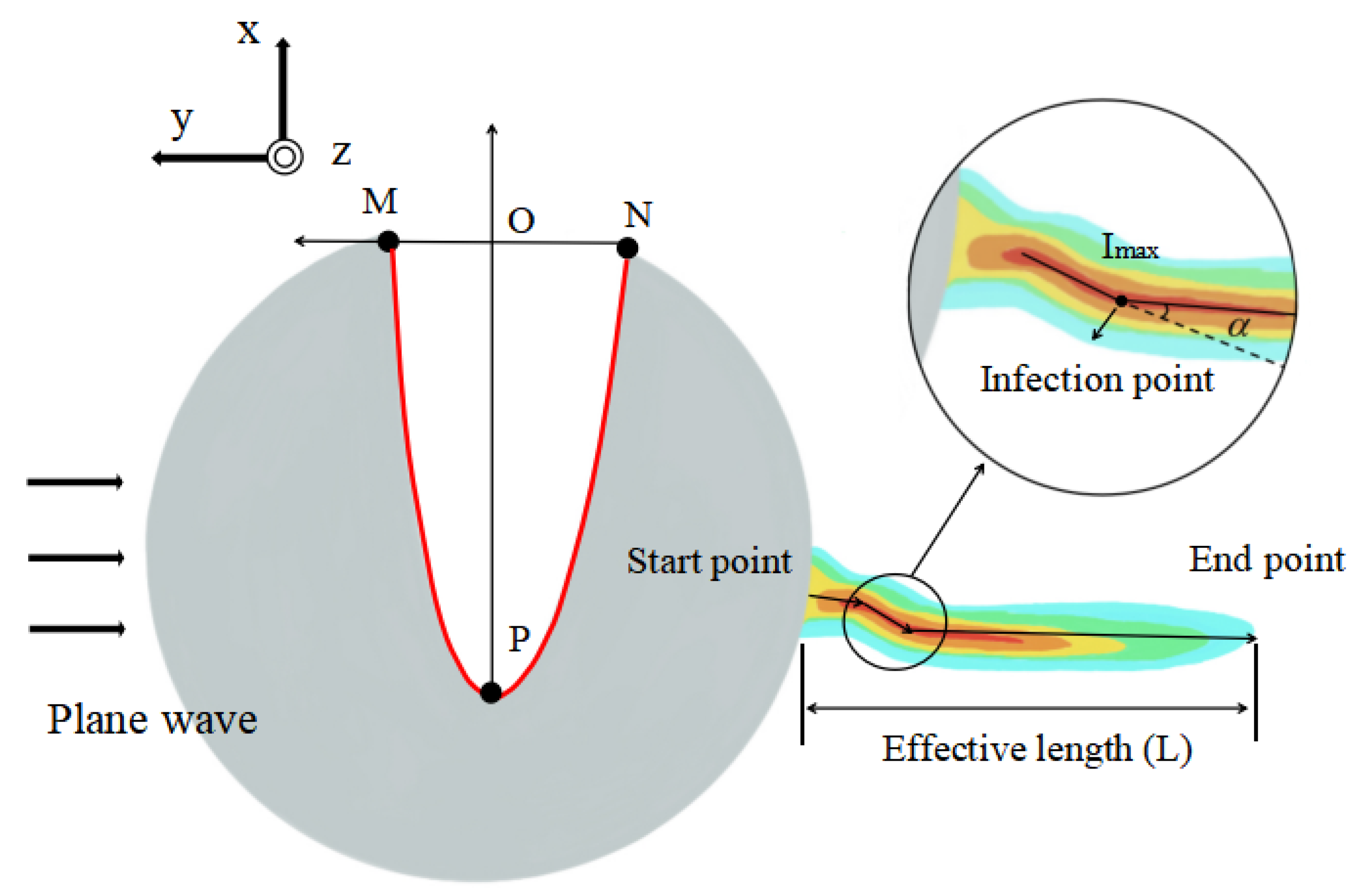
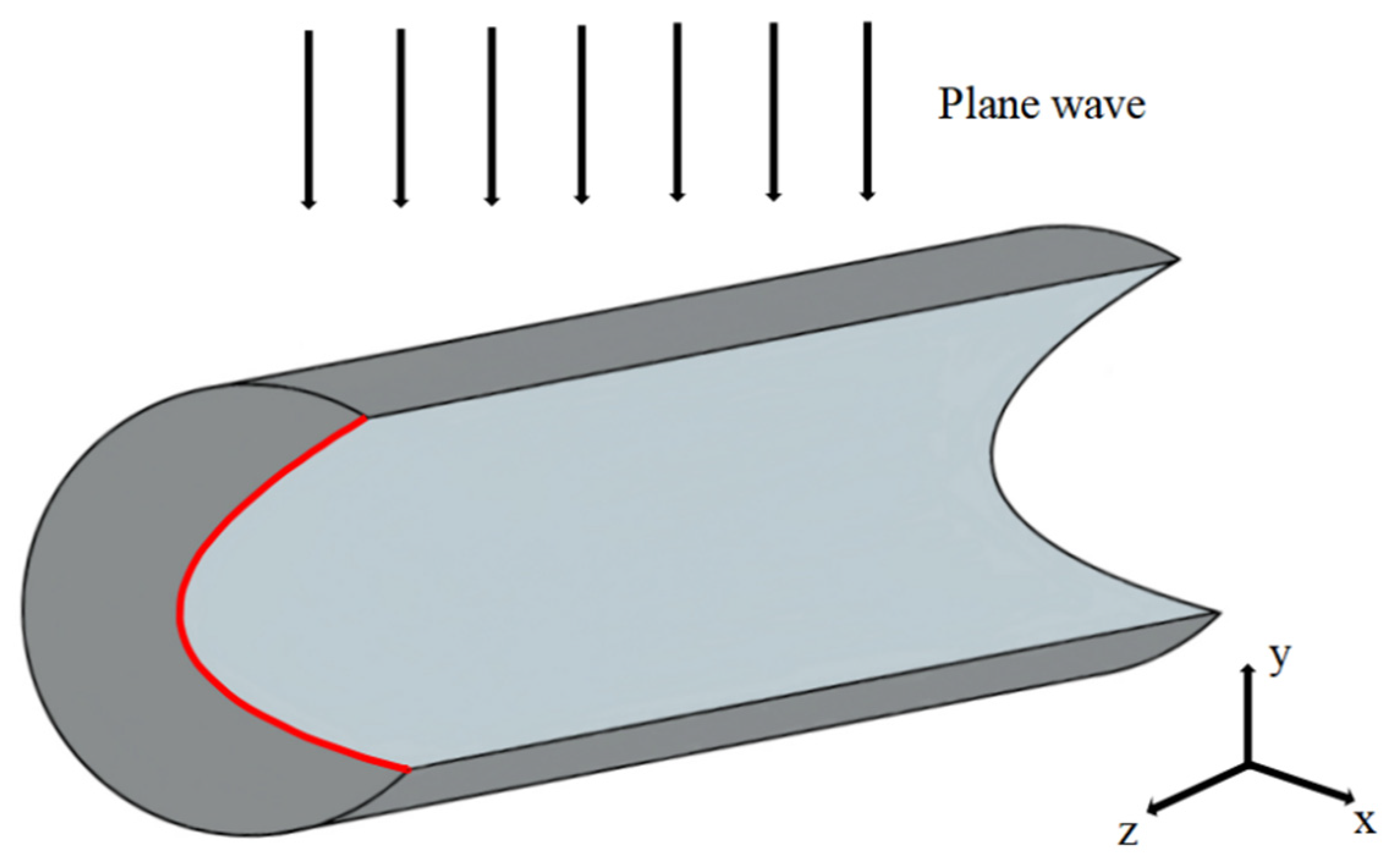
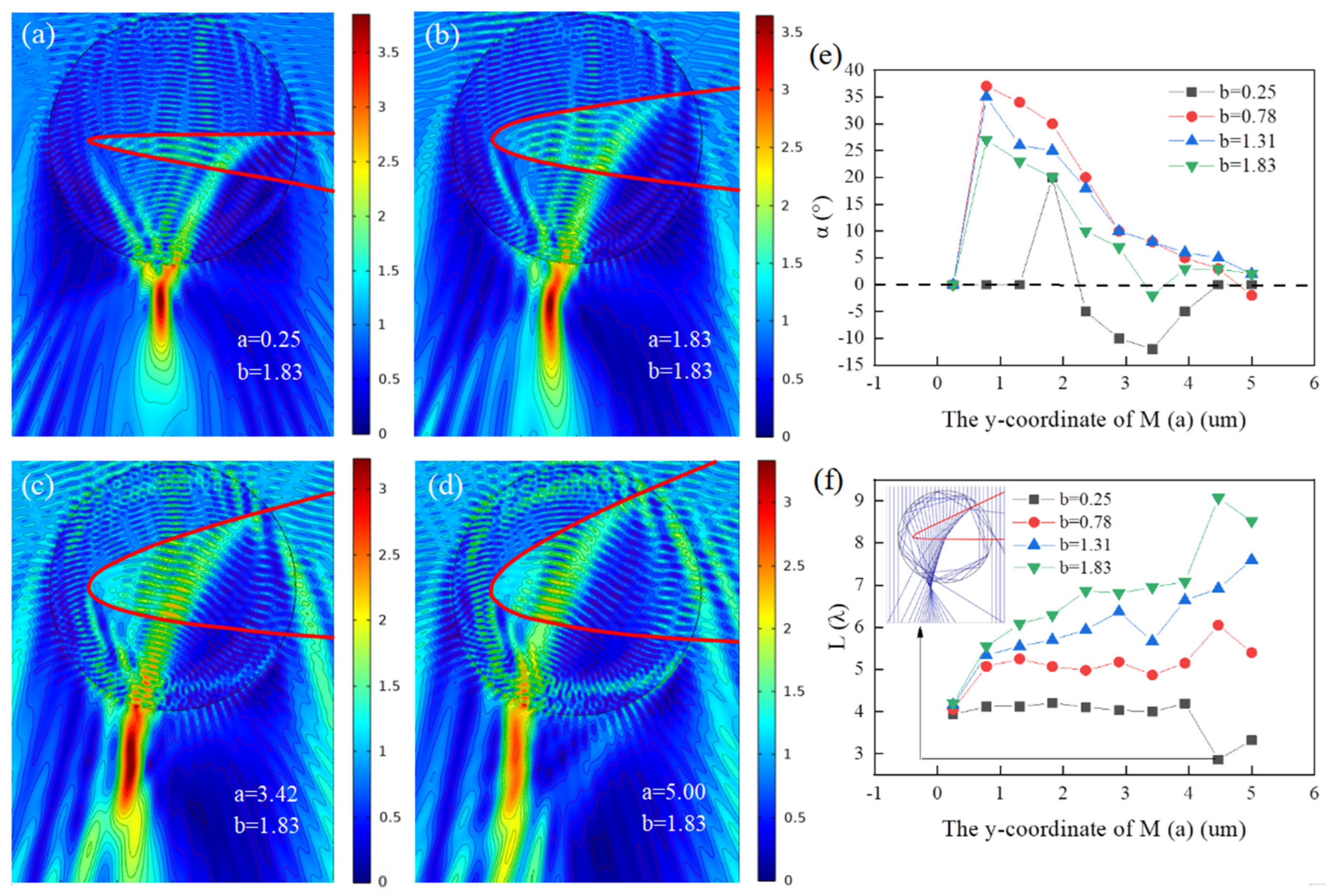
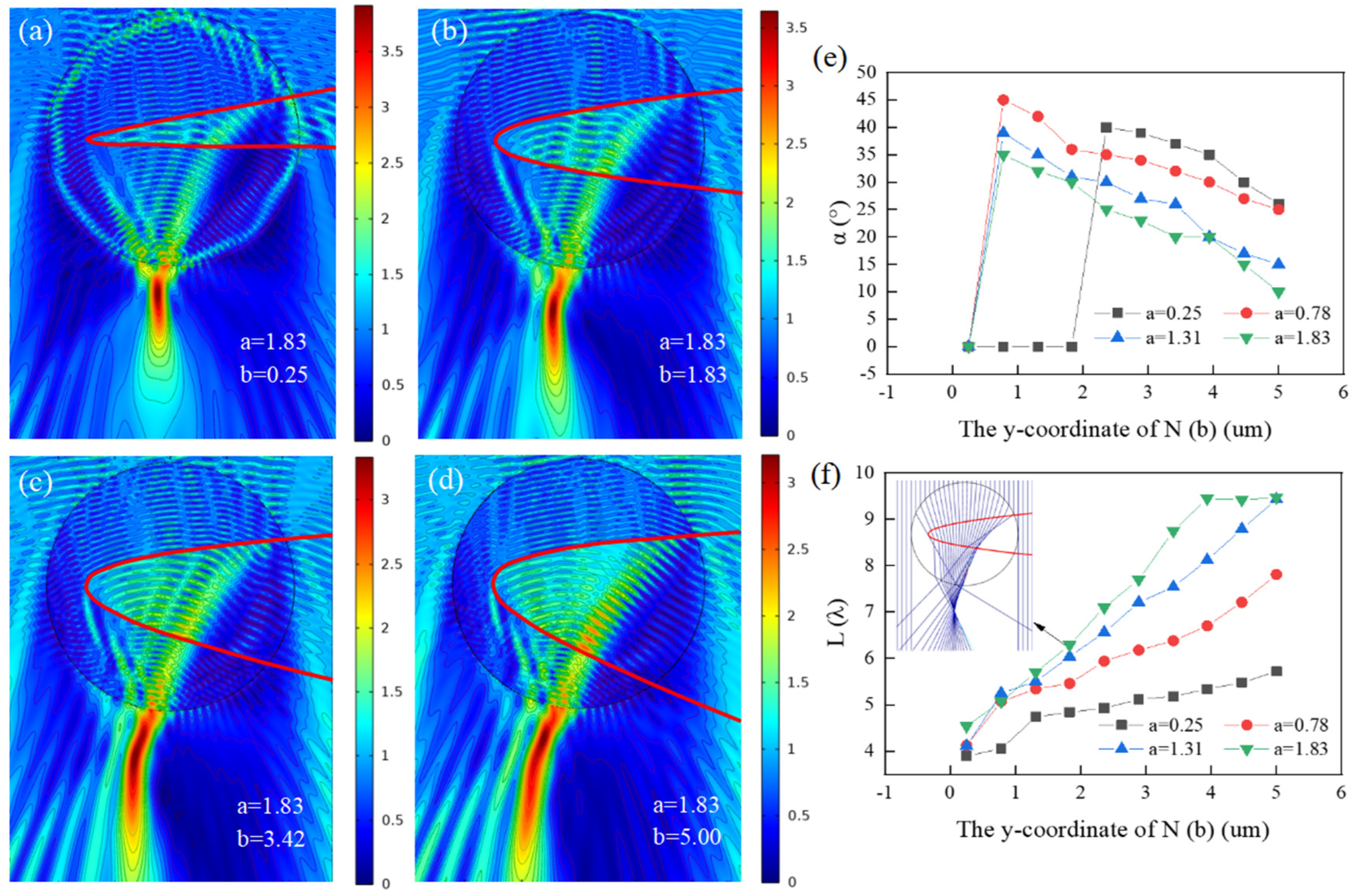
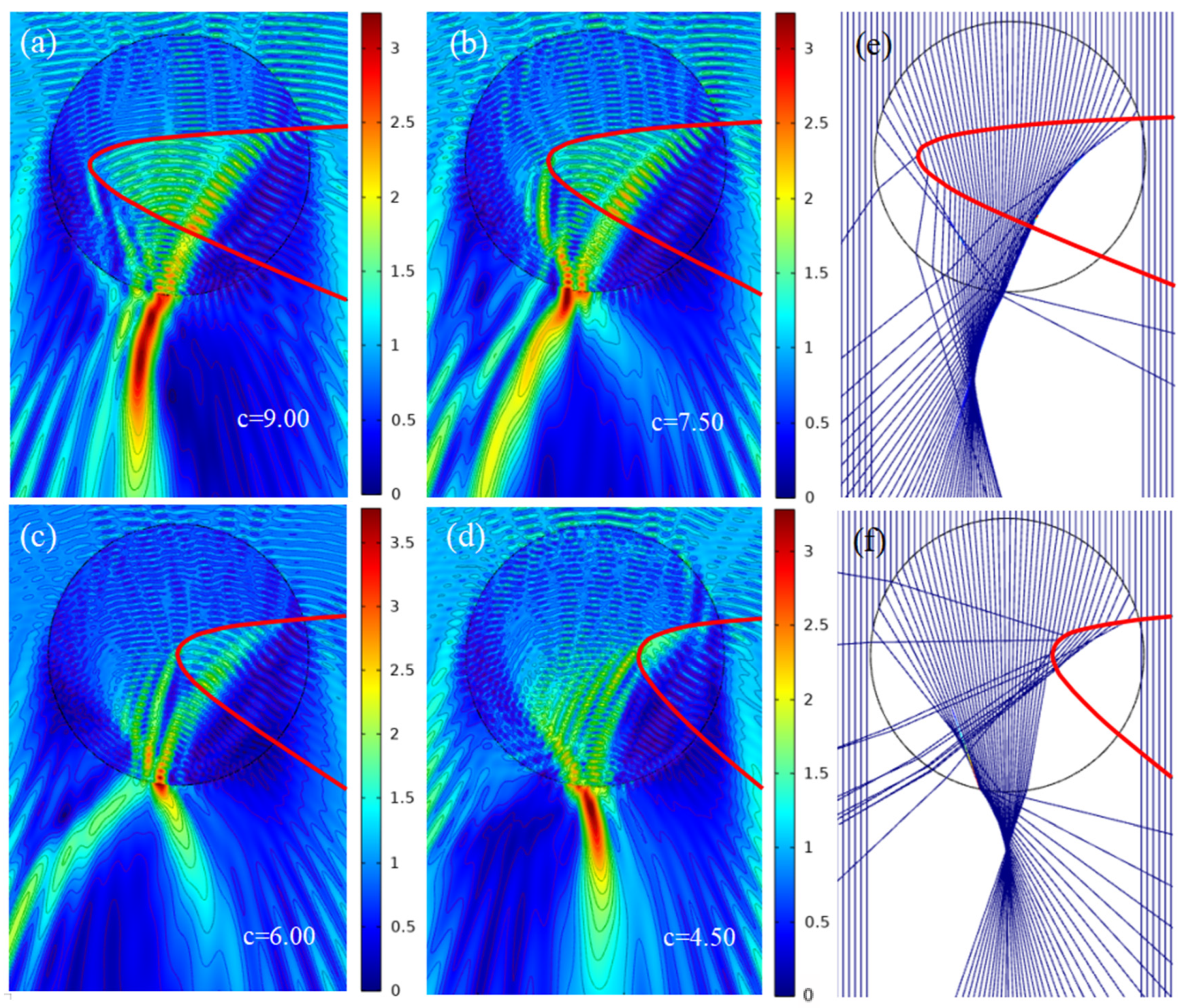
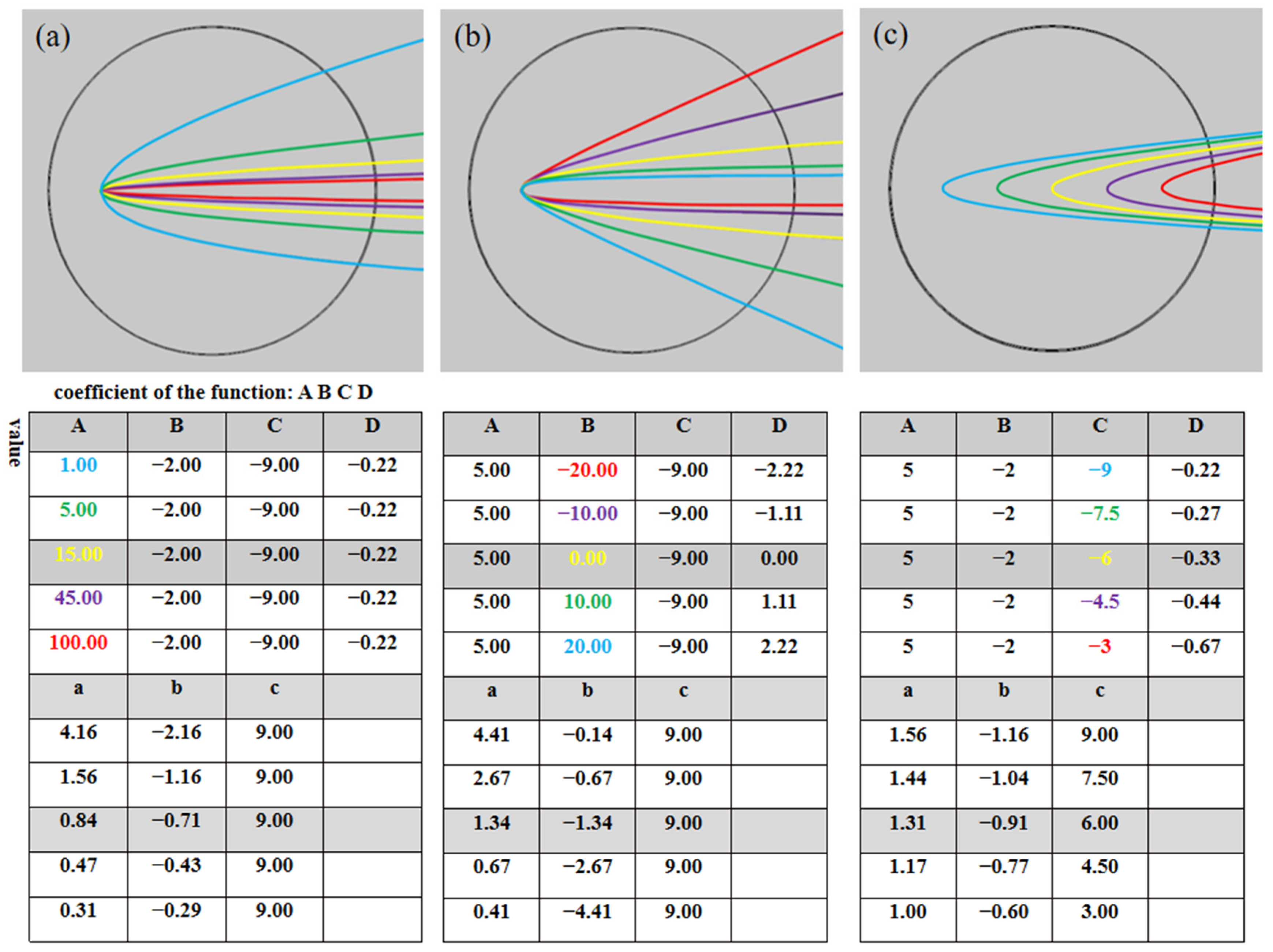
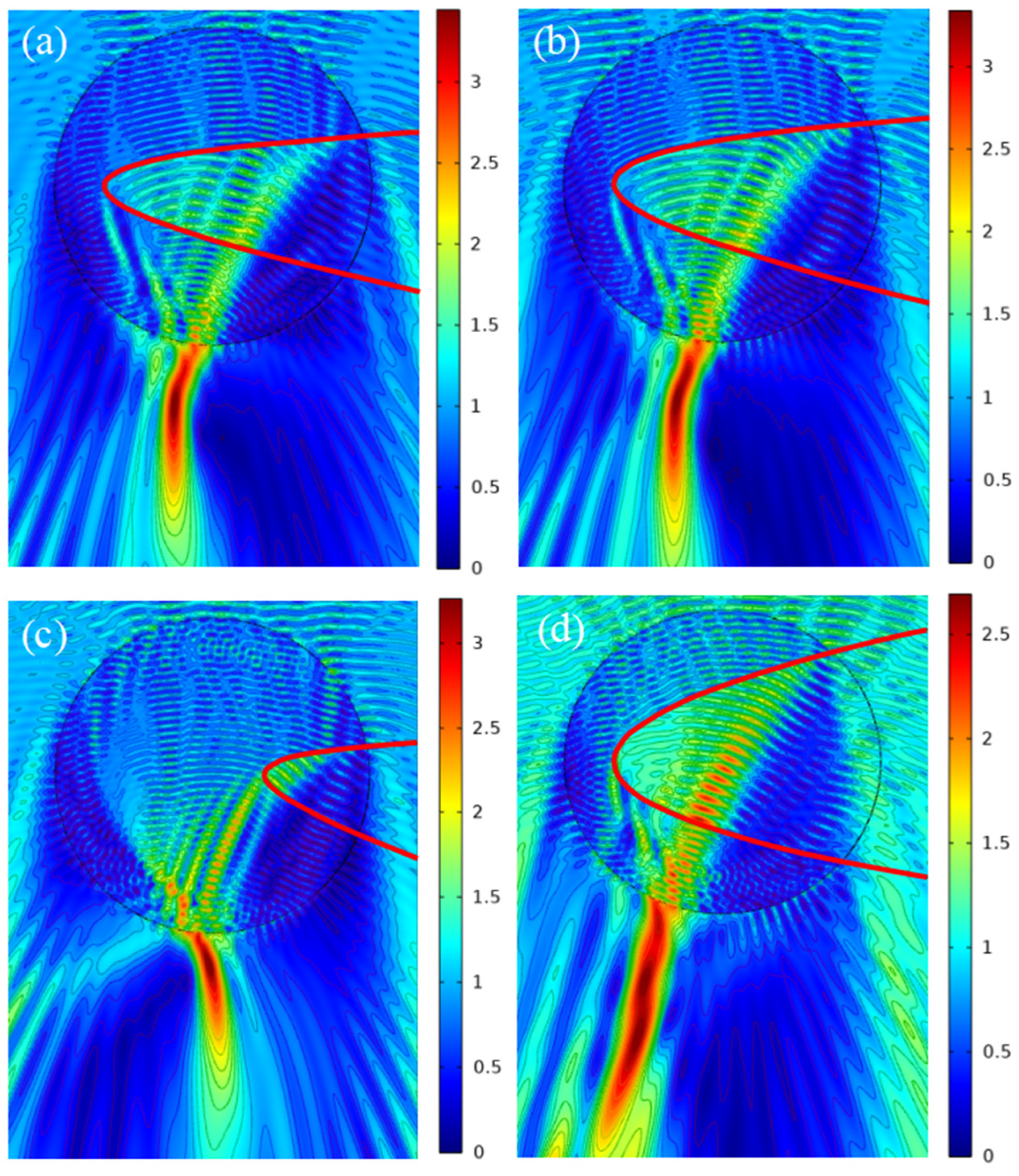
| Structure Type of the Particle | Method | The Range of the Bending Angle (°) | The Range of the Effective Length |
|---|---|---|---|
| Regular Structure | Asymmetry illumination | No data | No data |
| Asymmetry Materials | (−7.00, 29.70) | About 4.20~7.20 μm | |
| Asymmetry Structural | (6.00, 22.80) | About 1~3.00 μm | |
| Irregular Structure | Structure-constrained function | (−12.00, 46.00) and multiple bending | 7.53 μm |
Publisher’s Note: MDPI stays neutral with regard to jurisdictional claims in published maps and institutional affiliations. |
© 2022 by the authors. Licensee MDPI, Basel, Switzerland. This article is an open access article distributed under the terms and conditions of the Creative Commons Attribution (CC BY) license (https://creativecommons.org/licenses/by/4.0/).
Share and Cite
Zhang, J.; Han, G.; Yang, Z.; Xie, S.; Zhan, K. Photonic Hooks Generated by a Concave Micro-Cylinder Based on Structure-Constrained Functions. Micromachines 2022, 13, 1434. https://doi.org/10.3390/mi13091434
Zhang J, Han G, Yang Z, Xie S, Zhan K. Photonic Hooks Generated by a Concave Micro-Cylinder Based on Structure-Constrained Functions. Micromachines. 2022; 13(9):1434. https://doi.org/10.3390/mi13091434
Chicago/Turabian StyleZhang, Jialing, Guoxia Han, Ze Yang, Shuyue Xie, and Kaiyun Zhan. 2022. "Photonic Hooks Generated by a Concave Micro-Cylinder Based on Structure-Constrained Functions" Micromachines 13, no. 9: 1434. https://doi.org/10.3390/mi13091434
APA StyleZhang, J., Han, G., Yang, Z., Xie, S., & Zhan, K. (2022). Photonic Hooks Generated by a Concave Micro-Cylinder Based on Structure-Constrained Functions. Micromachines, 13(9), 1434. https://doi.org/10.3390/mi13091434





